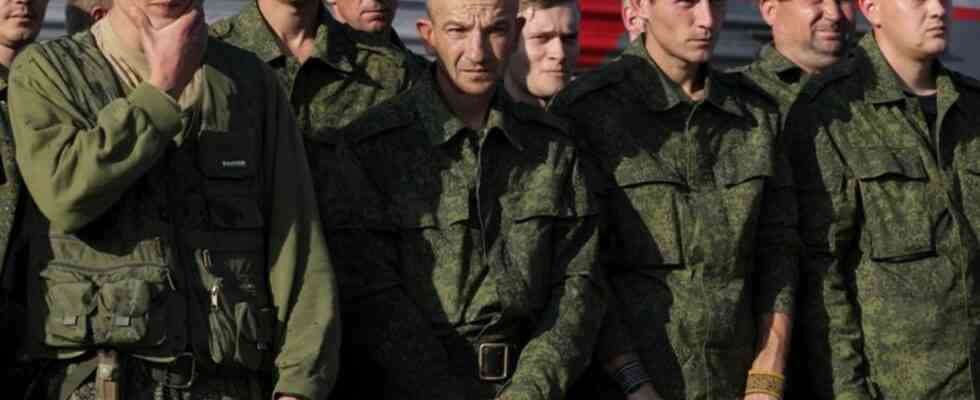partial mobilization
Russian military fails to stabilize front in Ukraine
Russian recruits wait for a train at a train station in the Volgograd region. photo
© -/AP/dpa
After the defeat at Kharkiv, Putin’s Ukraine front continues to crumble. Russian troops are retreating in the south and north-east of the country. There is a lack of staff and communication.
Withdrawal on a broad front: The Russian troops had to evacuate a huge area in southern Ukraine on the Dnipro after Ukrainian troops had advanced a good 30 kilometers behind the Russian lines along the river. For months, Russian units threatened the city of Kryvyi Rih, the birthplace of President Volodymyr Zelenskyy. However, due to the rapid advance of the Ukrainians, they themselves were suddenly in danger of being surrounded.
After the hasty retreat, the front is now less than 50 kilometers from the strategically important city of Nowa Kakhovka at the southern end of the Dnipro Dam. The pressure on the region’s capital, Cherson, is also increasing because Ukrainian troops are now marching towards the Black Sea port not only from the west, but also from the north.
“Deep operational crisis”
Russian military bloggers speak of a “deep operational crisis” and draw parallels with the defeat of their own army in the Kharkiv region in north-eastern Ukraine. There, at the beginning of September, Ukrainian troops also broke through the weak points of the front with rapid maneuvers. They penetrated deep into Russia’s backcourt, forcing Moscow into an ignominious retreat.
Russia’s problem: On this front section, too, it is not possible to stabilize the situation. The plan of the Russian army to establish itself along the rivers Oskil and Siwerskyi Donets after the extensive withdrawal from the Kharkov region is considered to have failed completely. After recapturing Kupyansk and Lyman in Donetsk Oblast, Ukrainian forces soon fully control the eastern bank of the rivers.
The cities of Svatowe and Kreminna are already being targeted as new targets of the Ukrainian approach. They are in the Luhansk region, which Moscow has actually already reported as having been completely conquered. Swatowe is considered an important transport hub that is important for supplying Russian troops in the region.
Factors: weather, reserves, supplies and will to win
The end of the Ukrainian advance seems to depend less on the decisions of the Russian army command than on the weather, reserves, supplies and the Ukrainian troops’ will to win. In particular, the autumn weather conditions with increasing rain and thus the notorious muddy period could at least slow down the Ukrainian offensive.
The Russian army, on the other hand, currently has little to oppose the advance for two reasons. You lack staff and communication. The front extends over more than 1000 kilometers. For the professional army that has been deployed there up to now, this means an overstretching, even with the separatist militias and mercenaries such as the Wagner group. The deployed soldiers are simply not enough to be present everywhere. By contrast, according to President Zelensky, Kyiv already had 700,000 men under arms after several waves of mobilization by the end of May.
Ukrainians attack gaps
The Ukrainians are taking advantage of the imbalance. They have found gaps with air and ground reconnaissance and are now attacking them skillfully. Instead of advancing with great artillery preparation and frontal attacks, the highly mobile Ukrainian units equipped with all-terrain vehicles are testing weak points in the thin Russian front line. They then break through in small groups, only to suddenly appear in the rear of the Russian positions. This approach is favored by modern satellite reconnaissance.
The counter-propaganda by the Ukrainian armed forces proudly showed in a video an “interactive display” with live data from western satellites. “While the occupiers use Soviet road maps, the Ukrainian army sees every Russian position online,” the communications center commented smugly on the video. During their counterattacks, the Ukrainian troops claim to have looted paper road maps left behind by the Russian soldiers, some of them from the 1970s.
In fact, Moscow’s warfare looks outdated. Chains of command are long and rigid. Russian military observers complain that it takes far too long for individual units to react in this way. She criticizes that the artillery often only fires when the Ukrainians have already left. Reserves would be brought in when the battle was over. Criticism is increasingly directed at the highest decision-making bodies in the General Staff and the Ministry of Defence. According to reports, only success reports are announced there, thus obscuring the true situation at the front.
Russia must be prepared for further rearguard action
This may also have led to the Kremlin’s very late reaction to the month-long losing streak. Only two weeks ago, President Vladimir Putin ordered partial mobilization. However, the 300,000 reservists will need a while before they are at the front. Until then, Russia must be prepared for further rearguard action.
According to experts, the number of reservists is not sufficient to completely reverse the balance of power. However, Moscow can use it to plug the gaps that are currently opening up. And then the Russian leadership relies on a proven ally – on General Winter. At the front he is supposed to stop the advance of the Ukrainians. In that time, Russia could gather new forces and reservists. The Russian armaments industry, which has now been mobilized, is also supposed to increase its output by then.
In addition, the Kremlin hopes that the cold in Europe, combined with high energy prices, will cause dissatisfaction among the population. Political scientist Abbas Galljamov explains that Putin now believes he has a means of exerting pressure on the West again. Russian gas would then only be available in exchange for concessions in Ukraine, says Galljamov, explaining the Kremlin chief’s way of thinking.

